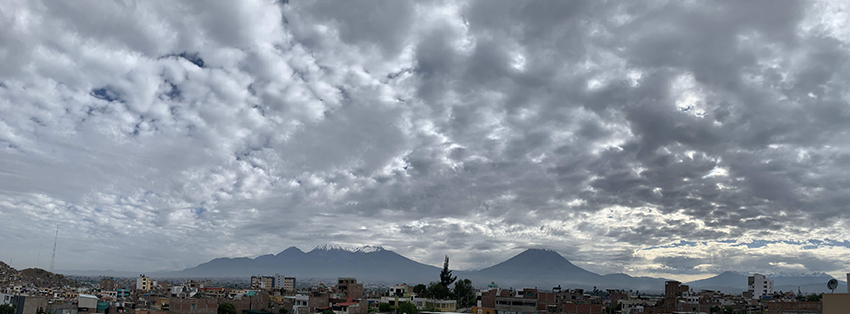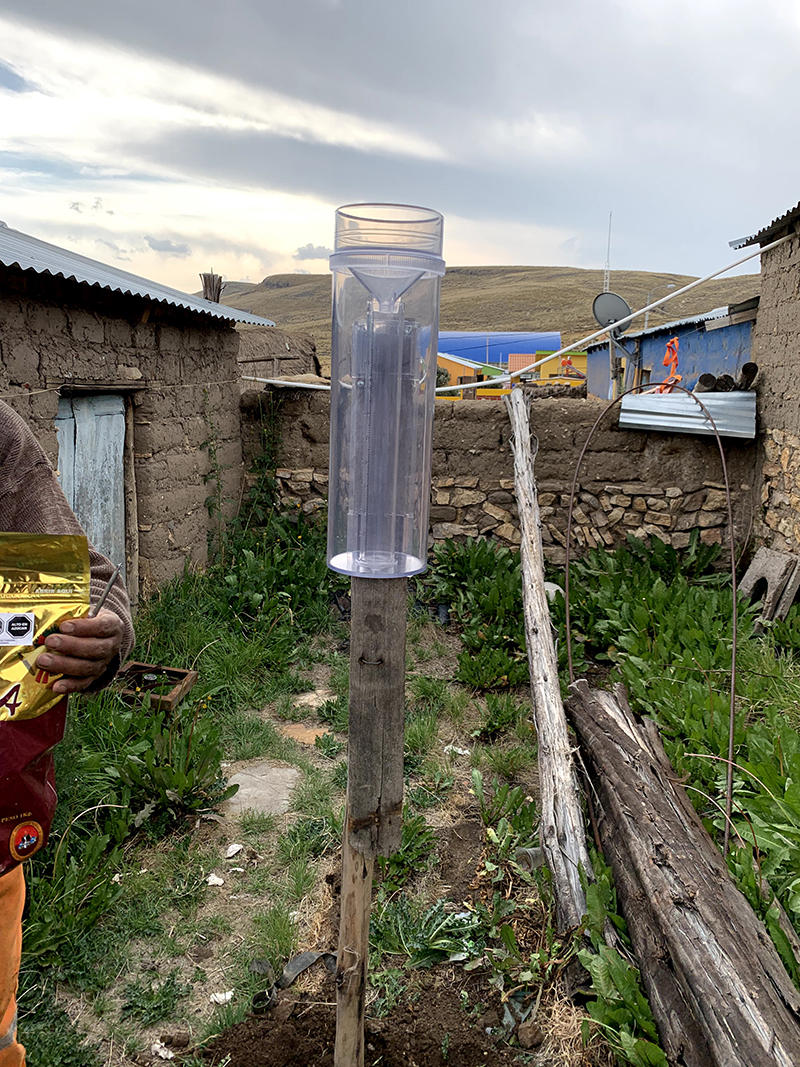Rainwater collected in the Andes Mountains contains fingerprints of atmospheric processes
10-03-2022

The Andes Mountains of Peru hold key evidence of the world’s most precious resource: water. Ice cores on the mountains reveal stable isotope signatures of warm and cold spells in the past and even cave stalactites store information about the water that has poured down over this region for thousands of years. Records from these regions are critical to helping produce climate models. Every piece of this ever-evolving research inches mankind closer to predicting weather patterns world-wide under a changing climate.
A team of researchers from Purdue University and the Universidad Nacional de San Augustín de Arequipa in southern Peru teamed up to study rains captured during the wet monsoon season and measure the oxygen and hydrogen stable isotopic ratios of the rainwater. This study of isotopic signatures of different rain generating atmospheric patterns was recently published in the American Geophysical Union's (AGU) Geophysical Research Letters (GRL). What they learned could change the way climate models are tested for this region and would have a ripple effect on paleoclimate studies.
Dr. Lisa Welp, Associate Professor of Purdue Earth, Atmospheric, and Planetary Sciences (EAPS), was the lead author of this study and worked with Elizabeth Olson, who at the time was a postdoctoral researcher with EAPS, Dr. Greg Michalski, EAPS Professor, Jonathan DeGraw, EAPS undergraduate student, as well as over 20 scientists from Arequipa who diligently collected rain in the region.

Rainwater collection sites like the one pictured were gathered by over 20 community participants from Arequipa so that the stable water isotopes could be measured. This measurement helped scientists at Purdue University determine where and how the rains were originating. Photo provided by Lisa Welp.
“These isotopic records are used to reconstruct past climate (wet/dry times) or the height of the Andes mountains when the rocks formed. Knowing how to read the isotopic records is really important for making the right conclusions,” said Welp. “This work indicates that at least in this mid to high elevation part of the west side of the Andes, the isotopic translation guide may need to be updated.”
Over the course of a year, local volunteer scientists in Peru would bottle collected rainwater each time it rained. When the bottles were returned to the lab at Purdue, collaborators in the Purdue Stable Isotope Lab measured the oxygen and hydrogen stable isotope ratios of the rain water to study the isotopic signature of different rain generating atmospheric patterns.
Weather in this region of Peru is often quite predictable except when it comes to rare storm events that can trigger landslides. The extremely arid western Andean rain shadow receives approximately 100 mm of precipitation each year. There is a short monsoon season from January to March and almost no rain for the rest of the year. Three atmospheric patterns can generate these monsoon-season rains in Arequipa. Mostly, strong winds from the east high in the atmosphere carry Amazonian moisture across the Andes to provide the rains, but other sources include Pacific Ocean evaporation from the west or evaporation from the north originating from the tropical Atlantic Ocean.
“In the Andes mountains, most rain comes from the Amazon basin,” explains Olson. “On the west coast of South America there is a rain shadow and in this very dry coastal desert past researchers have considered the rain to be of Pacific origin when the isotope measurements are high and to be of Amazon origin when they are low. We show that the Amazon moisture source can create high isotope values through sub-cloud evaporation at low elevations. This is new evidence based on high resolution rain sampling at daily intervals and smaller scale analysis of meteorological models. This research is important because these water isotopes are preserved in ancient climate records. By better understanding long-range moisture transport in the present, researchers can better interpret these archives and improve our understanding of the climate system in the past as well as into the future.”
The team learned that the isotopic signature of dominant easterly moisture transport was surprising enriched in heavy isotopes due to raindrops evaporating as they fall through the atmosphere between the cloud and the ground. Previously, enriched isotopic signatures have been interpreted as Pacific moisture influence. Welp explained that shifting winds transported isotopically depleted northerly moisture into the area for two weeks including two days of intense rainfall, flooding, and landslides in several communities.
“In 2019, we did not observe rain associated with Pacific evaporation from the west. These isotopic results indicate that there is more that we need to learn about how rain droplets interact with the surrounding air as they fall from high altitudes to the surface,” Welp says.
This project was funded by the Arequipa Nexus Project. The Nexus is a university collaborative research effort focused on research capacity building at the Universidad Nacional de San Augustin (UNSA) in Arequipa, Peru. The research focused on increasing UNSA's research in environmental and sustainability sciences. Welp says she benefitted from discussions with atmospheric science colleagues in EAPS when she was working on the weather pattern analysis. Michalski also analyzed the rain samples for the chemistry of the particles they scrub from the air for a future interpretation study related to air quality controls.
“We are really lucky to work with such wonderful scientists in Peru,” says Welp. “We were also fortunate to that Elizabeth and Jonathan were excellent scientists who were also fluent in Spanish. Their language skills were critical to the success of the project.”
Research such as this that analyze precipitation around the world benefits all climate scientists because it helps to establish a more complete climate modeling system.
“The weather patterns that result in rainfall in this study location in the Andes area very large and affect rainfall in other parts of northern South America,” explains Welp. “There is an analysis of the past few decades that suggests that the northern moisture weather pattern just turned on, perhaps due to a warmer northern Amazon. There are also other large mountains that show a surprising amount of the heavy isotopes in rain on the downwind side, so the raindrop evaporation process that we see in the Andes may very likely be occurring in other areas too.”
About the Department of Earth, Atmospheric, and Planetary Sciences at Purdue University
The Department of Earth, Atmospheric, and Planetary Sciences (EAPS) combines four of Purdue’s most interdisciplinary programs: Geology & Geophysics, Environmental Sciences, Atmospheric Sciences, and Planetary Sciences. EAPS conducts world-class research, educates undergraduate and graduate students, and provides our college, university, state and country with the information necessary to understand the world and universe around us. Our research is globally recognized, our students are highly valued by graduate schools, employers, and our alumni continue to make significant contributions in academia, industry, and federal and state government.
Writer: Cheryl Pierce, Communications Specialist
Contributors: Dr. Lisa Welp, Associate Professor, and Elizabeth Olson, former EAPS postdoctoral researcher
Photos provided by Dr. Adriana Larrea Valdivia